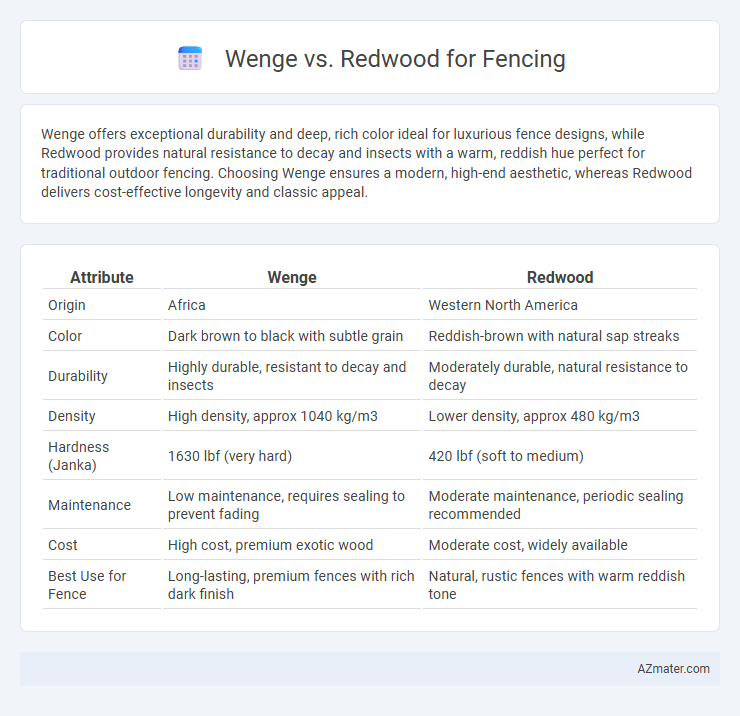Wenge offers exceptional durability and deep, rich color ideal for luxurious fence designs, while Redwood provides natural resistance to decay and insects with a warm, reddish hue perfect for traditional outdoor fencing. Choosing Wenge ensures a modern, high-end aesthetic, whereas Redwood delivers cost-effective longevity and classic appeal.
Table of Comparison
| Attribute | Wenge | Redwood |
|---|---|---|
| Origin | Africa | Western North America |
| Color | Dark brown to black with subtle grain | Reddish-brown with natural sap streaks |
| Durability | Highly durable, resistant to decay and insects | Moderately durable, natural resistance to decay |
| Density | High density, approx 1040 kg/m3 | Lower density, approx 480 kg/m3 |
| Hardness (Janka) | 1630 lbf (very hard) | 420 lbf (soft to medium) |
| Maintenance | Low maintenance, requires sealing to prevent fading | Moderate maintenance, periodic sealing recommended |
| Cost | High cost, premium exotic wood | Moderate cost, widely available |
| Best Use for Fence | Long-lasting, premium fences with rich dark finish | Natural, rustic fences with warm reddish tone |
Introduction to Wenge and Redwood Fencing
Wenge and Redwood are popular choices for fencing due to their durability and aesthetic appeal. Wenge, a tropical hardwood from Central Africa, offers a deep chocolate-brown color with dense grain, providing excellent resistance to rot and insects, making it ideal for long-lasting outdoor structures. Redwood, native to the western United States, features a rich reddish hue with natural tannins that enhance its decay resistance and weather adaptability, ensuring a visually striking and robust fence.
Origins and Botanical Differences
Wenge wood, native to West Africa, comes from the Millettia laurentii tree, known for its dense, dark brown to black grain with fine texture ideal for durable fencing. Redwood, sourced from the coast of California, USA, is derived from Sequoia sempervirens, exhibiting rich reddish hues with a softer, more fibrous texture that offers natural resistance to decay and insects. The primary botanical difference lies in Wenge's dense hardwood and tight grain, contrasting with Redwood's softer, lightweight coniferous structure, impacting both aesthetic and longevity in fencing applications.
Appearance and Color Comparison
Wenge wood features a rich, dark brown to almost black hue with subtle grain patterns, creating a sleek, modern appearance ideal for contemporary fence designs. Redwood offers warm, reddish-brown tones with a natural, rustic character highlighted by prominent grain lines, providing a classic and inviting look. Both woods age beautifully, with Wenge developing a deeper patina while Redwood tends to soften to a silvery-gray over time under outdoor exposure.
Durability and Lifespan
Wenge wood offers exceptional durability with natural resistance to decay, insects, and moisture, typically lasting 25 to 30 years when used for fencing. Redwood also provides high durability due to its dense grain and natural oils, with an average lifespan of 20 to 25 years in outdoor conditions. Both woods require minimal maintenance but Wenge's higher density generally results in superior longevity for outdoor fence applications.
Resistance to Weather and Decay
Wenge wood offers exceptional resistance to weather and decay due to its dense, oily composition that repels moisture and inhibits fungal growth, making it ideal for outdoor fencing. Redwood is naturally rich in tannins, providing solid durability against rot and insect damage, but it is generally less dense than Wenge, which can affect its long-term weather resistance. For fences exposed to harsh climates, Wenge's superior density and natural oils ensure greater protection and longevity compared to Redwood.
Maintenance Requirements
Wenge wood requires minimal maintenance due to its natural resistance to decay, insects, and moisture, making it ideal for long-lasting fence installations. Redwood also offers excellent durability but demands more regular upkeep, including periodic sealing and staining to preserve its rich color and prevent weathering. Choosing Wenge reduces the frequency of maintenance tasks, while Redwood requires proactive care to maintain its aesthetic appeal and structural integrity.
Environmental Impact and Sustainability
Wenge and Redwood differ significantly in environmental impact and sustainability for fencing. Wenge, sourced primarily from Central African rainforests, faces challenges due to deforestation and slow growth rates, making it less sustainable. Redwood, native to the Pacific coast of the United States, is often harvested from managed forests with certifications like FSC, promoting sustainable forestry and a lower ecological footprint.
Cost and Value Analysis
Wenge wood generally costs more than redwood due to its rarity and rich dark color, which offers a luxurious, high-end aesthetic for fences. Redwood provides excellent value with its natural resistance to decay and insects, making it a cost-effective choice for durable fencing. While wenge delivers a unique, exotic appearance that increases property appeal, redwood balances longevity and affordability, optimizing overall investment in fencing projects.
Best Applications for Each Wood Type
Wenge wood, known for its dense, dark grain and high durability, is ideal for modern, elegant fence designs requiring resistance to decay and insect damage, especially in harsh climates. Redwood's natural oils provide excellent weather resistance and a rich reddish hue, making it perfect for traditional or rustic fences with an emphasis on natural beauty and ease of maintenance. For longevity and structural strength, Wenge excels in high-traffic areas, while Redwood offers superior dimensional stability and color retention in moderate weather conditions.
Conclusion: Choosing the Right Wood for Your Fence
Wenge offers exceptional durability and a rich dark finish ideal for a modern, elegant fence, while Redwood provides natural resistance to decay and a warm reddish tone suited for traditional styles. Both woods deliver strong weather resistance, but Wenge's density makes it more resistant to dents and scratches compared to Redwood's softer texture. Select Wenge for longevity and a sleek appearance, or Redwood for natural beauty and easier workability in fence construction.

Infographic: Wenge vs Redwood for Fence
 azmater.com
azmater.com